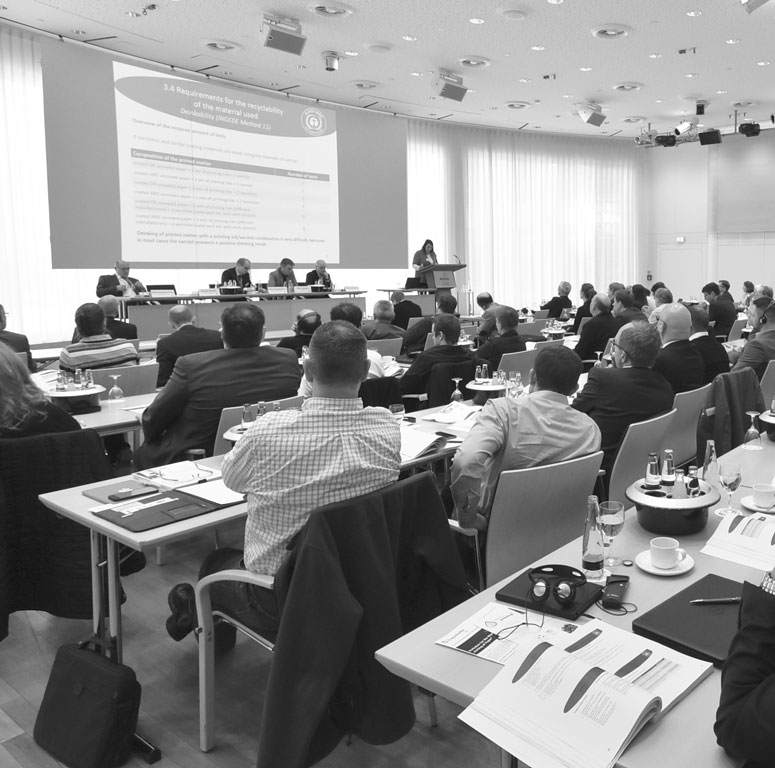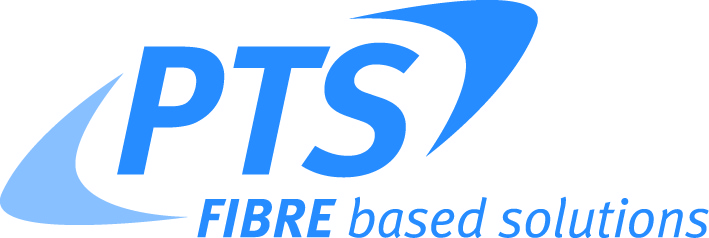The new agreement on the circular economy package and potential orientations for paper recycling
 Ulrich Leberle,
Ulrich Leberle,
CEPI, Brussels
Status of the negotiations:
- European Parliament and Council reached an informal agreement on 17 December
- Text is not yet available
- Different elements of relevance:
- calculation method
- separate collection
- recycling targets
- minimum requirements for EPR
The IMPACTPapeRec Project
- Final conference 24 January 2018
- Handbook on good and best practices
- Translations in several languages
- Continuation of the IMPACT Commitment
- COLLECTORS: H2020 project
- Top 5 recommendations for policy measures
Ecolabels: Soft Legislation to Educate Printers and Print Customers
Andrea Rimkus,
RAL gGmbH, Bonn
Blue Angel products differ from other products with the same use in better environmental sustainability and more health protection. Additionally the products fulfil high requirements on the fitness for use.
All printing houses, who want to continue to label their products with the Blue Angel after 2018, have to have a product group awarded pursuant to RAL-UZ 195.
RAL-UZ 195 – The Blue Angel for printed matter
Printed matter such as newspapers, magazines, books, catalogues, prospectuses, advertising inserts, brochures, flyers, calendars, operating instructions, posters and billboards are widely disseminated. Energy and resources such as paper and ink are required for their production. The printing process and the cleaning of the machines can lead to the emission of volatile organic solvents that contribute to the production of ozone and “summer smog”. In a comparison of their impact on ecological systems, those paper products made out of recovered paper perform significantly better in terms of their use of resources, wastewater load and water and energy consumption than paper products made predominantly from virgin fibres. Therefore, the use of paper with a high proportion of recovered paper contributes to the preservation of resources, especially ecosystems such as forests, and to a reduction in waste during the manufacture of printed matter. In addition, the printed matter should allow for the recycling of its paper fibres through the use of suitable inks, varnishes and adhesives. Optimizing procedures during the printing process can also reduce energy usage, waste paper and air and water emissions. Printed matter that has been awarded the Blue Angel ecolabel thus represents an environmentally-friendly alternative to standard printed matter available on the market.
INGEDE Project 153 17 Deinkability Survey
 Hans-Joachim Putz,
Hans-Joachim Putz,
PMV, Darmstadt
INGEDE has initiated many deinkability investigations on digital print products and print products foreseeable to be difficult to deink. The last large deinking project dealing with the dominant print products within the most important paper for recycling grade 1.11.00 was more than 10 years ago: INGEDE Project 100 05, the “Recyclability Survey 2005”. So it was about time for a new look into the deinkability of print products – those which make up the majority in sorted graphic paper for deinking (1.11.00).
Important categories of print products were chosen, such as:
- Newspapers
- Rotogravure magazines
- Offset magazines
- Catalogues and
- Avertising leaflets.
The print products were tested in mixtures. This allowed to keep the number of tests and the project costs within acceptable limits. One subgroup allowed to determine the effect of dispersion or UV varnished magazine covers.
UV Inks and Varnishes – Opportunities, Markets, Technology and Deinkability
 Roland Schröder, hubergroup,
Roland Schröder, hubergroup,
and Axel Fischer, INGEDE, Munich
Lack of deinkability is yet the characteristic feature of almost all UV-curable printing inks. Roland Schröder of hubergroup, combining 40 ink manufacturers internationally, called the current status “from hubergroup’s view not satisfactory”.
Despite a continuous growth of UV applications in all sectors of the printing industry, there is “too little pressure from outside” to support deinking and recycling – it is “not in the focus of brand owners and end customers”, Schröder said. He compared the search for an improvement with a 100-meter run, currently still within the first meters.
Axel Fischer of INGEDE complemented Schröder’s presentation with examples of problems created by prints with UV-cured inks – and of printers that advertise with false environmental claims, especially for “LE-UV” prints to be mineral oil free and therefore “green”.
History of Inkjet Printing and New, Better Deinkable Processes
 David Croll,
David Croll,
Océ Printing Systems, Poing
In this presentation, an overview of the history of flotation deinking results for Océ water-based inkjet prints will be reviewed. The developments in both inkjet papers and Océ inkjet inks leading to improved flotation deinking will be shown. Significant progress in flotation deinking performance with the newest ink technologies has been made, supported by knowledge from joint DPDA-INGEDE deinking research. Finally, the deinking results with the latest Océ printing machine development will be presented.
Closing the Loop for Paper Towels – A Journey From Washroom Behaviour to New Opportunities

 Sara Lundström,
Sara Lundström,
Essity, Sundsvall
Moving from a linear to a circular economy is key to create a sustainable future. Every actor throughout society needs contribute to enable a successful shift. Recycling paper is common, but until now, paper hand towels have been an exception. That’s why Essity and its brand Tork, have developed a unique service collecting used hand towels and recycling them locally into new tissue products. In this way, we close the loop for what we put on the market and lead the way toward more circularity in professional hygiene, while helping our customers deliver on key environmental targets such as waste reduction and carbon footprint reduction.
A major challenge has been to create a service that is hassle free and easy to participate in, as well as cost efficient, while still meeting the mill requirement of max 2% contaminations among the collected hand towels. This has been achieved by developing the service in close cooperation with customers, cleaning companies, recycling partners and our mills.
Quo vadis Mixed Paper?
 Andreas Faul, INGEDE, Bietigheim-Bissingen, Uwe Wollschläger, PROPAKMA, and Manfred Geistbeck, UPM
Andreas Faul, INGEDE, Bietigheim-Bissingen, Uwe Wollschläger, PROPAKMA, and Manfred Geistbeck, UPM
Sourcing deinking grade paper for recycling from households can be done in several ways. Predominant is the municipal collection of graphic paper together with paper-based packaging products – the so-called mixed paper. This has to undergo subsequent sorting.
Highly filled and coated graphic products as well as white top liners in packaging affect the mechanical properties. This, and increasing shares of packaging in the household collection, give reason to re-think existing concepts: How can one provide the optimum quality of paper for recycling to the paper recycling and deinking industry?
Current Projects, Success Stories and Possible Future Research Activities in Recycling/Deinking at CTP
![]() Benjamin Fabry,
Benjamin Fabry,
CTP, Grenoble

Influence of digital print products on the deinking behaviour of paper for recycling mixtures in a 2-stage deinking process
 Saskia Runte, PMV, Darmstadt
Saskia Runte, PMV, Darmstadt
Due to the digitalisation of the media landscape, the amount of digitally printed products in paper for recycling is increasing gradually. Up to now, it has been common to investigate the deinking behaviour of individual printing products using INGEDE method 11 in an one-stage deinking process. At PMV, a 2-loop method was developed to simulate in laboratory scale a two-stage flotation deinking process with one dispersion stage in between. This method was used to analyse the deinking behaviour of individual paper for recycling products as well as product mixtures. For analysing the deinkability of different paper for recycling mixtures, a reference mixture consisting of 40 % offset-coldset newspapers, 10 % offset-heatset advertising materials, 30 % offset heatset magazines and 20 % rotogravure magazines was deinked. After that, 10 % and 30 % of the newspapers were substituted by pigment based inkjet test prints. These mixtures were deinked, as well. Furthermore, the deinkability of a mixture with 30 % liquid toner test prints (Indigo) instead of offset-heatset magazines was investigated. Finally, different amounts of the print products from the reference mixture were substituted by 30 % inkjet and 30 % Indigo test prints for evaluation of the deinkability behaviour of this mixture.
From lab qualitative and quantitative macrosticky measurements to the first on-line prototype
![]() Benjamin Fabry,
Benjamin Fabry,
CTP, Grenoble
Stickies are the origin of many disturbances (deposits, defects, breaks both in the paper machine and during converting) in the paper recycling process. Among the various proposed methods to quantify macrostickies, none of them is able to perform both quantitative and qualitative measurements. In this context, CTP developed a new macrosticky sensor allowing to (i) determine the 3-dimensional morphology of screened contaminant without any deformation of them and to (ii) determine the chemical nature of the identified contaminants (not only sticky particles). This is achieved by a combination of laser triangulation and local near-infrared (NIR) spectroscopy. This sensor, called 3D-Stick, is fully automated giving quantitative and qualitative measurements with good correlation with INGEDE Method 4.
How is my Process Water? Improving the Quality of Deinked Pulp
Elisabeth Hanecker, 
PTS, Munich,
and Hans-Joachim Putz
Deinking mills are forced to reduce their fresh water consumption with a resulting higher load of various contaminants in the process water. This has an influence on achieving the target brightness levels since more bleaching chemicals are now required to recover the optical properties.
The objective of the work was to determine the main reason explaining poorer DIP quality or poorer deinking potential based on the impact of process water quality. This required a systematic assessment of differences in process water quality and their impact on the development of optical properties in the deinking process. From the results solutions will be worked out for improving the deinking results depending on the process water quality.
The tests regarding the impact of process water samples on process water properties and the deinking potential of paper for recycling were carried out with process water from DIP lines. Process water properties of different deinking plants vary significantly. The storage of process water can impact both the process water characteristics and the deinking potential of paper for recycling.
Paper Industry 4.0: The Digital Revolution in Papermaking?
 Jürgen Käser,
Jürgen Käser,
Voith, Heidenheim
Optimierte Papierherstellungsprozesse mithilfe des “Internet of Things”
Die klassische Prozessoptimierung durchläuft eine Revolution. Alte Fragen finden neue und bessere Antworten als jemals zuvor: Wodurch erreicht man den höchsten Zeitwirkungsgrad? Welche Rohstoffrezepturen senken die Betriebskosten nachhaltig ohne die Produktivität negativ zu verändern?
Welcher Zusammenhang besteht zwischen Abrisshäufigkeit und Betriebsführung?
Welcher Primärenergieeinsatz ist absolut unvermeidbar für eine Sorte? Sind feste Wartungsintervalle der Weisheit letzter Schluss?
Lang geglaubt Stabilität von Papierprozessen wird durch die heute mögliche Datenerfassung und Verarbeitung ad absurdum geführt. Die hohe digitale Bearbeitungsgeschwindigkeit erlaubt es sogar in Echtzeit Muster zu erkennen.
Dabei entscheiden Algorithmen zwischen unterschiedlich geeigneten Modellen.
Diese, in schnellen Regelungen mit Aktuatoren umgesetzt, wenden den jeweils optimalen Satz von Prozessparametern für einige Millisekunden an. Das Ergebnis ist lange Zeit verfügbar und kann abgerufen werden, wenn es benötigt wird.
Diese neue Prozessdynamik ergibt hochstabilisierte und kostengünstige Herstellungsprozesse, welche bislang für Menschenhände unerreichbar waren.
Dabei bleibt die Physik dieselbe. Aber Sensoren, Aktuatoren und Regelungen organisieren sich in Datenwolken zu hocheffizienten Prozessoptimierern.
Erste Praxisanwendungen zeigen: Die Papierherstellung steht am Anfang einer digitalen Revolution.

 Thomas Krauthauf,
Thomas Krauthauf,  Peter Hengesbach,
Peter Hengesbach,